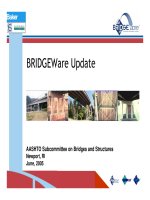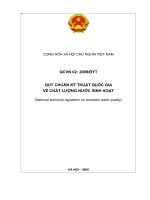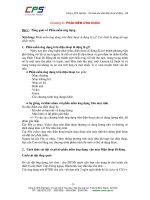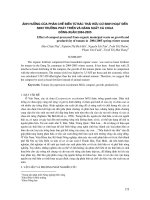Filters enveloping 09 2005
Bạn đang xem bản rút gọn của tài liệu. Xem và tải ngay bản đầy đủ của tài liệu tại đây (472.74 KB, 29 trang )
Filters and Enveloping
- A Practical Discussion -
William Tudoroff
Condition Monitoring Services Product
Manager
Rockwell Automation
Copyright © 2005 Rockwell Automation, Inc. All rights reserved.
1
Agenda Sample
1.1.Basic
BasicFilter
FilterTerminology
Terminology
2.2.Basic
BasicFilter
FilterTheory
Theory
3.3.Rolling
RollingElement
ElementBearing
BearingFaults
Faults
4.4.Applying
ApplyingEnvelopes
Envelopes
Copyright © 2005 Rockwell Automation, Inc. All rights reserved.
2
Consider This Simple Vibration Signal in the
Time Domain
0
1
20 Hz Time Waveform
60 Hz Time Waveform
Raw Time Waveform
Copyright © 2005 Rockwell Automation, Inc. All rights reserved.
3
Amplitude
Or in the Frequency Domain
20 Hz
40 Hz
60 Hz
Frequency
Copyright © 2005 Rockwell Automation, Inc. All rights reserved.
4
Basic Filter Terminology – High Pass Filter
High Pass Filter – Allows Frequencies Higher than the filter value to be
retained in the signal – also known as the Low Corner Frequency*
Amplitude
40 Hz High Pass Filter
20 Hz
40 Hz
60 Hz
Frequency
*Remember
*Remember –– IfIf it’s
it’s an
an important
important concept
concept in
in the
the world
world of
of Vibration,
Vibration,
there
there must
must be
be more
more than
than one
one name
name for
for itit
Copyright © 2005 Rockwell Automation, Inc. All rights reserved.
5
Basic Filter Terminology – Low Pass Filter
Low Pass Filter – Allows Frequencies Lower than the filter value to be
retained in the signal – also known as the High Corner Frequency or
Frequency Maximum
Amplitude
40 Hz Low Pass Filter
20 Hz
40 Hz
60 Hz
Frequency
Copyright © 2005 Rockwell Automation, Inc. All rights reserved.
6
Basic Filter Terminology – Band Pass Filter
Band Pass Filter – Allows Frequencies in the Band defined by the filter
value to be retained in the signal – also known as Enveloping
Amplitude
30 - 50 Hz Band Pass Filter
20 Hz
40 Hz
60 Hz
Frequency
Copyright © 2005 Rockwell Automation, Inc. All rights reserved.
7
Basic Filter Theory – When Does the
Filtering Occur?
• Although we have visualized the filter in the Frequency Domain – the actual
signal processing can occur in either the Frequency or Time Domain.
• Also, when filtering in the Frequency Domain, this can occur in the
hardware as the data is being processed, or in the Software, after the data
has been processed
Copyright © 2005 Rockwell Automation, Inc. All rights reserved.
8
Basic Filter Theory – Analog Filter
• Filtering in the Time Domain is also called an Analog Hardware Filter
because the filtering occurs during the actual capture of the Time
Waveform.
Analog Input
Analog Filter
Digital Output
Analog to Digital
Converter
Digital Signal
Processor
Copyright © 2005 Rockwell Automation, Inc. All rights reserved.
9
Basic Filter Theory – Analog Filter
Raw Time Waveform (Analog Input from Sensor)
If the Raw Time Waveform was made up of the 20 Hz and 60 Hz
Signals Below
0
1
20 Hz Time Waveform
40 Hz Analog High Pass Filter
60 Hz Time Waveform
This becomes the Analog Signal Sent to the Analog to Digital Converter
Copyright © 2005 Rockwell Automation, Inc. All rights reserved.
10
Basic Filter Theory – Analog Filter is a Roll
Off Filter
• An Analog Filter is considered a Roll-Off Filter – in other words the filter is not a brick wall but
allows some of the signal beyond the filter value to pass through
• The Filter “Attenuates” or reduces the amplitudes of the frequencies below the filter value
• The filter values will be defined by the hardware manufacturer as they are an actual Analog Chip
• Lets visualize it in the Frequency Domain – even though the filtering is occurring in the Time
Domain
Copyright © 2005 Rockwell Automation, Inc. All rights reserved.
11
Basic Filter Theory – Analog Filter is a Roll
Off Filter
40 Hz High Pass Filter
Amplitude
Roll-Off
20 Hz
40 Hz
60 Hz
Frequency
Copyright © 2005 Rockwell Automation, Inc. All rights reserved.
12
Basic Filter Theory – Digital Filter
• Filtering in the Frequency Domain is often called a Digital Hardware Filter
because the filtering occurs during the actual Digital Signal Processing of
the Time Waveform into a Frequency Spectrum
Analog Input
Analog Filter
Digital Output
Analog to Digital
Converter
Digital Signal
Processor
Fast Fourier Transform, Integration and Digital
Filtering Occur Here
Copyright © 2005 Rockwell Automation, Inc. All rights reserved.
13
Basic Filter Theory – Digital Filter
• A Digital Filter is considered an Absolute Filter – in other words the filter is
essentially a brick wall, allowing none of the signal beyond the filter value to pass
through
• The filters available are dependent on the hardware being used
• Most common example is the Frequency Maximum (FMAX) setting we are all
familiar with
Amplitude
40 Hz FMAX
20 Hz
40 Hz
60 Hz
Frequency
Copyright © 2005 Rockwell Automation, Inc. All rights reserved.
14
Basic Filter Theory – Software Filter
• Filtering in the Frequency Domain after the data has been processed in the
hardware is called a Software Filter because many vendors just display
Zero amplitude in any bins (lines of resolution) that are being filtered out
• Thus, an infinite number of filters is available using this method
Amplitude
40 Hz High Pass Filter
20 Hz
40 Hz
60 Hz
Frequency
Copyright © 2005 Rockwell Automation, Inc. All rights reserved.
15
A Word About Bearings
The vast majority of bearings are one of two types:
Rolling Element, or “Anti-Friction” Bearings and Fluid Film Bearings
Accelerometer
Eddy Current Probe
bearing
bearing
housing
bearing
bearing
housing
Soft Metal
(Babbitt)
Oil Wedge
(load zone)
Fluid Film: Capable of supporting very high loads, high temperatures,
high speed. Expensive and associated rotor dynamics are very complex.
Rolling Element: Low cost, simple to
apply. But are capable of only moderate speeds
and relatively light loads. Rotor dynamics aren’t
bad but diagnostics can be complex due to all
those spinning balls!
Copyright © 2005 Rockwell Automation, Inc. All rights reserved.
16
Rolling Element Bearing Faults
What happens when there is a fault or defect on the inner or outer race of the
bearing?
Accelerometer
bearing
bearing
housing
We feel an impact anytime a ball or
roller passes over the defect
Fault or Defect
on Outer Race
This impact energy is typically very low
amplitude
Copyright © 2005 Rockwell Automation, Inc. All rights reserved.
17
Rolling Element Bearing Faults
• In fact, the vibration energy from a bearing fault is so small sometimes that
it gets hidden by all the other machine vibration going on:
– Unbalance, Looseness, Misalignment, etc
Copyright © 2005 Rockwell Automation, Inc. All rights reserved.
18
Remember our Band Pass Filter or Envelope
• If we pass the signal through the right Envelope or High Pass Filter, we
could theoretically leave only the vibration generated by our bearing fault
Amplitude
Band Pass Filter
Frequency
Copyright © 2005 Rockwell Automation, Inc. All rights reserved.
19
Enveloping and High Pass Filtered Signal
Amplitude
• Our Enveloped or High Pass Filtered Signal would look like this:
Copyright © 2005 Rockwell Automation, Inc. All rights reserved.
20
What Envelope or High Pass Filter Should
We Use?
• We need to know what frequency or frequencies we are trying to isolate
• The frequencies are generated by the impact of the ball or roller as it
passes over the defect on the race
• So what frequency is this?
Copyright © 2005 Rockwell Automation, Inc. All rights reserved.
21
What Envelope or High Pass Filter Should
We Use?
• If we envelope properly, we should be able to eliminate all the higher
amplitude, low frequencies that are present in the signal:
Unbalance Frequency (1X)
Misalignment Frequencies (1X and 2X)
Looseness Frequencies (1X and 2X and possibly more running speed harmonics)
Fundamental Bearing Defect Frequencies (Non-harmonics from around 3X to
around 40X)
Amplitude
–
–
–
–
• So what frequency is this?
Copyright © 2005 Rockwell Automation, Inc. All rights reserved.
22
Bearing System Natural Frequencies
• If we envelope properly, all we should have left is the bearing natural
frequency response to the impacts that are occurring as the balls or rollers
pass over the defect(s)
• Why?
– Because this gives us a measure of the energy generated by any impacts or impulses
on the system
– Since we are measuring the amount of resonance occurring in the system, it will be
very sensitive to the severity of the impacts and hence, the severity of the fault
– If measured properly, we should see almost all bearing related energy
Copyright © 2005 Rockwell Automation, Inc. All rights reserved.
23
What High Pass or Envelope Filters are
Available in the Hardware?
• Rockwell Automation (Entek and IRD Brands)
– Use Analog High Pass Filters
– 100 Hz, 200 Hz, 500 Hz, 1 KHz, 2 KHz and 5 KHz
• SKF
– Use Analog Envelope Filters
– 5 to 100 Hz, 50 to 1000 Hz, 0.5 to 10 kHz, 5 to 40 kHz and 250 to 350 kHz
• CSI
– Use Analog High Pass Filters
– 500 Hz, 1 KHz, 2 KHz and 5 KHz
• Both CSI and Rockwell Automation then apply a digital low pass filter to the
signal to create the Envelope
Copyright © 2005 Rockwell Automation, Inc. All rights reserved.
24
Amplitude
What Does the Spectrum Look Like?
Amplitude
What are These?
Frequency
Copyright © 2005 Rockwell Automation, Inc. All rights reserved.
25









